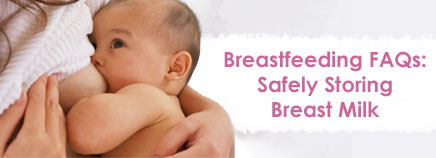
Whether you’re a new mom or a seasoned parenting pro, breastfeeding often comes with its fair share of questions. Here are answers to some common queries that mothers — new and veteran — may have.
How do I store my breast milk?
You can freeze and/or refrigerate your pumped (or expressed) breast milk. Store it in clean bottles with screw caps, hard plastic cups that have tight caps, or nursing bags (pre-sterilized bags meant for breast milk).
It’s helpful to label each container with the date when the milk was pumped (and your baby’s name if the milk is going to childcare providers). You can add fresh cooled milk to milk that is already frozen, but add no more than is already in the container. For example, if you have 2 ounces of frozen milk, then you can add up to 2 more ounces of cooled milk.
How long, exactly, can I store my breast milk?
For healthy full-term infants:
- You can store it at room temperature:
- for 6 to 8 hours (at no warmer than 77°F, or 25°C)
- You can store it in the refrigerator:
- for up to 5 days at 32°–39°F (0°–3.9°C)
- You can store it in the freezer (be sure to leave about an inch of space at the top of the container or bottle to allow for expansion of the milk when it freezes):
- for up to 2 weeks in a freezer compartment located inside the refrigerator
- for 3 to 6 months in a freezer that’s self-contained and connected on top of or on the side of the refrigerator and is kept at 0°F (–18°C). Store the milk in the back of the freezer, not in the door.
- for 6 to 12 months in a deep freezer that’s always -4°F (–20°C)
To thaw frozen milk, you can move it to the refrigerator (it takes 24 hours to thaw), then warm by running warm water over the bag or bottle of milk and use it within the next 24 hours. If you need it immediately, then remove it from the freezer and run warm water over it until it’s at room temperature. Do not refreeze it. Once your baby has started to drink from the bottle, you should use it within 1 hour.
You may find that different resources provide different variations on the amount of time you can store breast milk at room temperature, in the refrigerator, and in the freezer. Talk to your doctor if you have any concerns or questions.
How much of my milk should I store in the freezer?
Although some women may choose to pump large volumes to be frozen, it’s a good idea to actually store the breast milk in 2- to 4-ounce (59.1 to 118.2 milliliters) portions so as not to waste any. Label the bottles, cups, or bags with the date, then freeze them.
You also could pour the milk into ice cube trays that have been thoroughly cleaned in hot water, let them freeze until hard, store them in freezer bags, then count up the amount of cubes needed to make a full bottle.
My frozen breast milk changed color. Is this OK?
Breast milk that’s been frozen or refrigerated may look a little different from fresh breast milk, but that doesn’t mean it’s gone bad. It’s normal for early breast milk to look kind of orange and the mature milk to look slightly blue, yellow, or brown when refrigerated or frozen. And it may separate into a creamy looking layer and a lighter, more milk-like layer. If this happens, just swirl it gently to mix it up again.
Thawed milk may smell or taste soapy due to the breakdown of fats in the milk. The milk is still safe to drink, and most babies won’t have a problem with it. If your baby doesn’t like it, the milk can be heated to scalding (bubbles around the edges) right after it is pumped or expressed and then quickly cooled and frozen. This switches off the enzyme that breaks down the milk fats.
How do I clean bottles and pump parts?
Before their first use, wash and then sterilize the nipples, bottles, and washable breast pump supplies (for example, the breast shields and any other part that touches your breasts or your milk) by boiling them for 5 to 10 minutes. Check the manufacturer’s recommendations for the length of time to boil the parts.
You also can sterilize the parts with a countertop or microwaveable sterilizer, but boiling works just as well and costs nothing. After that, wash the bottles, nipples, and pump supplies in hot, soapy water (or run them through the dishwasher) after every use. They can transmit bacteria if not cleaned properly.
Is it safe to microwave my baby’s bottles?
The microwave can create dangerous “hot spots” in bottles of formula or breast milk, so you should never microwave them. Instead, you can run the bottle or freezer bag under warm water for a little bit, swirl the bag or bottle around in a bowl of warm water, or thaw the milk in the refrigerator.
You also can put your baby’s bottles in a pan of warm water (away from the heat of the stove) and then test the temperature by squirting a drop or two on the inside of your wrist before feeding your baby. And bottle warmers are available for use at home or in the car.

